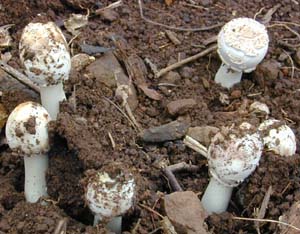Mushroom poisoning
|
|
Mushroom poisoning refers to symptoms that can vary from slight gastrointestinal discomfort to death resulting from ingestion of toxic substances present in a mushroom. The toxins present are metabolic by-products produced by the fungus. Typically, mushroom poisoning is the result of a wild mushroom gatherer mistakenly identifying a toxic mushroom as a non-toxic or edible mushroom. Because some edible and poisonous fungi have a similar appearance, mistakes are usually due to misidentification based on superficial characteristics. Even very knowledgeable wild mushroom gatherers are sometimes poisoned, despite being well aware of the risks.
| Contents |
No golden rule for safety
There are many folklores providing misleading tips on defining features of poisonous mushrooms, such as:
- Having bright flashy colours. (Actually, some toxic ones are pure white).
- Lack of snail or insect infestation. (While a fungus may be harmless to invertebrates, it could be toxic to humans. The Death Cap is often perforated by larvae).
- Becomes black when touched by silverware or an onion. (Most mushrooms tend to darken as they wither).
- Poisonous mushrooms smell and taste horrible. (Some poisonous mushrooms actually taste delicious, according to victims).
- Any mushroom becomes safe if cooked enough. (The chemical structure of some toxins is very stable, even at high temperature).
In reality, there are no simple guidelines to identify poisonous mushrooms. The only foolproof rule for preventing mushroom poisoning is abstinence — it's better to be safe than sorry (or "When in doubt, throw it out"). Some academic mycologists in fact do not eat wild mushrooms, despite their professional knowledge. Persons who gather wild mushrooms should follow some practical guidelines (see Mushroom hunting). In particular, they should NOT:
- eat any mushroom they cannot positively identify;
- allow small children to gather mushrooms for consumption;
- mix known edibles with questionable species while gathering, since parts may break off and intermix.
Recommendations that one should follow:
- Know the characteristics (shape, color, growing terrain, etc...) of all the toxic mushrooms growing in your area. In Europe and North America, these include the deadly Amanita phalloides and Amanita virosa, as well as the Amanita pantherina and Amanita muscaria, but this list is not exhaustive. Know well the local toxic mushrooms. Remember, what looks like an edible from back home may be something entirely different in a new location! (Note recent reports of confusion between Volvariella speciosa, an edible species, and Amanita phalloides, a deadly poisonous species.)
- Stick to mushroom species you know and with no risks of confusion with toxic species.
Symptoms
Serious symptoms do not always occur immediately after eating; often not until the toxin attacks the kidney, from minutes to hours later. In rare cases, symptoms leading to death may not appear for days after eating a poisonous mushroom. Symptoms typically include:
If treated promptly, death can usually be avoided. Otherwise, with some toxins, death could result within a week or a few days, if the species ingested is potent.
Poisonous species
Three of the most lethal mushrooms are from the genus Amanita: the Death Cap (A. phalloides), Destroying Angel (Amanita virosa, and Amanita verna). These species cause the greatest number of fatalities. The principal toxin is alpha-amanitin.
The following species may cause great discomfort, but are less often lethal.
- Amanita muscaria (Fly Agaric) – poisonings rare, possibly because its unique and obvious appearance make it easily identifiable; however, its long history of use as an entheogen and new reports suggesting it is less toxic than once thought may suggest otherwise.
- Amanita pantherina (Panther Mushroom) – Contains similar toxins as Amanita muscaria, but in higher quantities; first signs of distress occur after 8-12 hours; 80-85% of victims survive.
- Amanita regalis – symptoms generally mild
- Entomola spp. – highly poisonous, such as Livid Entomola (Entomola sinuatum), Entomola rhodopolium, and Entomola nidorosum. First symptoms appear after 20 minutes to 4 hours.
- Galerina – Some species contain alpha-amanitin (deadly posionous)
- Cortinarius orellanus – First symptoms appear after 3-14 days, death may occur in 2-3 weeks.
- Many Inocybe spp. – Inocybe fastigiata, Inocybe geophylla, and Inocybe patouillardii
- Some white Clitocybe – First symptoms after 15-20 minutes
- Tiger Tricholoma – no lasting effect after 2-6 hours of great pain.
- Sulfur Tuft – poisoning may be serious
- Omphalotus olearius – mild
- False Morel (Gyromitra esculenta) – may not affect some people at all
- Brown Roll-rim – once thought edible, but now found to be destructive of red blood cells with regular or long-term consumption.
- Devil's Boletus (Boletus satanas) – some people claim that it is safe if well-cooked
- Purple Boletus (B. rhodoxanthus) –
- Coprinus atramentarius – poisonous only if consumed with alcohol.
- Conocybe filaris contains amatoxins, sometimes though to be a Psilocybe.
External links
- Mushroom toxins (http://vm.cfsan.fda.gov/~mow/chap40.html) from the Center for Food Safety & Applied Nutritionde:Pilzvergiftung

